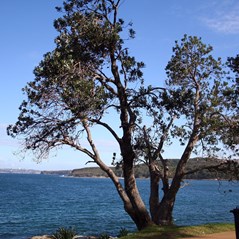Uses: Highly tolerant of full coastal conditions and can be used for beach reclamation and erosion control. Useful urban tree for wider streetscapes, parks and reserves. A hardy and fast growing ornamental. Requires well-drained soils.
Attracts native birds and insects for food source and habitat.
Cultural use: Indigenous peoples soaked the flower spikes to make a sweet drink and dry cones to make implements.
Banksia's can be a little difficult to prune. They do respond well to light pruning but too much can result in heavy leaf growth at the expense of flowers. Pruning too hard into old wood can result in permanent damage to the tree
Note: This species is provisionally classified schedule 1, Regulation 24.2 under the Sewerage Act. Written approval is required prior to planting in streets or roads. It should not be planted closer than two metres to any sewer main or connection.
- Canopy Shape Spreading
- Height 10-20m
- Spread 5-10m
- Position
- Full Sun
- Family Proteaceae
- Botanical Name Banksia integrifolia
- Common Name Coast Banksia
- Origin Qld, Vic, NSW, Tas
- Habit Upright, Dense, Spreading
- Landscape Coast, Coastal cliffs, Coastal footslopes, Hills, Plains, 2nd line coast, Footslopes
- Soil Texture Clay, Loam, Sand
- pH Acidic, Alkaline, Neutral
- Tolerates Drought, Lime, Moderate frost, Salt spray, Wind, Fire
- Supplementary Watering Minimal
- Flower Colour Yellow
- Flowering Time Spring, Winter
- Foliage Dark-green
- Flower Type Cylindrical spike
- Purpose Ornamental, Shade
- Evergreen/Deciduous Evergreen
- Seasonal Colour Spring
- Trunk Rough
- Form Tall Tree (Usually exceeds 10m)







